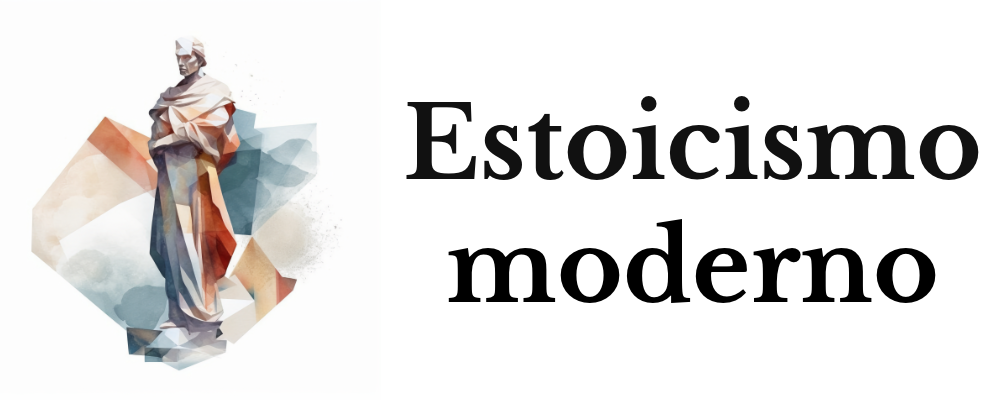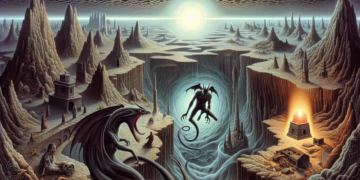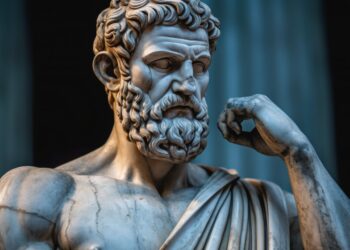In the twilight of an era etched by technology and globalization, humanity confronts dilemmas that seem to whisper echoes of ancient myths. One such legend, that of Sisyphus, has transcended centuries, reborn in our daily struggles. Through the prism of Stoicism, a school of thought that has re-emerged time and again during moments of human crisis, the myth of Sisyphus reveals unexpected facets—mirrors reflecting both existential anguishes and the triumphs of the human spirit.
The Stoics have bequeathed to us a robust and practical philosophical framework, with which we can decode the odyssey of this king doomed to eternal punishment—pushing a boulder up a hill only to see it roll back down. To eyes trained in Stoic discipline, Sisyphus emerges not just as a symbol of futility, but also as an icon of human persistence and will.
Proem: Virtue Lies in Effort
Consider the exhortation of Marcus Aurelius, who, in “Meditations,” invites us to ponder our role in the cosmos: “Don’t squander what’s left of your life on speculations about others, unless you’re contemplating how to do them some good.” Rather than lamenting fate or plunging into an abyss of fatalism, the Stoics instruct us to focus on our power to act virtuously, independent of the ultimate outcome.
The Fate of Sisyphus: A Call to Self-Examination
Sisyphus, in his eternal toil, might be seen as a victim of cruel fate, a pawn played by capricious gods. Yet, in viewing Sisyphus through a Stoic lens, we realize his sentence is also an altar to self-examination: What is within our control? What isn’t? Epictetus, in his “Enchiridion,” advises: “In our power is our action; in other hands, the outcome.”
Likewise, the myth of Sisyphus challenges us to distinguish between external circumstances—the boulder, the hill, the repetitive cycle—and our internal attitude—resilience, determination, a sense of purpose. Ultimately, it is the disposition with which Sisyphus assumes his task that redeems or condemns him anew.
Recurrence: An Opportunity for Growth
Sisyphus’s punishment is an eternal return to the starting point. Yet, beyond the apparent curse, might there be a hidden Stoic lesson? Seneca offers insight in “On the Shortness of Life”: “As one wave follows another, so each of our actions is succeeded by another… as in all circular motion.” The process is not merely repetition but rhythm and consistency, hallmark elements of the learning and personal growth process.
Thus, Sisyphus’s boulder becomes a symbol of our own struggles, repetitive goals, and failures. With every push of our burdens, we have the opportunity to do so with increased wisdom and strength, exercising virtue, the ultimate Stoic end.
Self-Determination in Adversity
Self-determination is key in Stoic study. Our rock is not just a burden but also a teacher, a molder of character. Like Sisyphus, we face circumstances that may seem immovable, yet it is our capacity to persevere that shapes genuine self-determination.
Stoicism reminds us that mastery over one’s own spirit is the true freedom. “It is not what happens to us that affects us, but how we react to it,” stated Epictetus. In the face of adversity, it is the Stoic attitude that compels us to assert our intention and will, regardless of the chains of fate.
Practical Advice from the Stone
- Morning Reflection: Each day, before dawn, remember the rock awaiting you. Prepare your spirit for the daily challenge with reflections of gratitude and determination.
- Active Acceptance: Do not succumb to pessimism. Accept your rock, not passively, but actively. Stoicism invites you to embrace it as the raw material with which you will carve out your hope and courage.
- Mental Reservation: As you undertake your tasks, do so with a mental reservation (a “might not turn out as I hope” clause), which will allow you to face the blows of fate with greater equanimity.
- Inner Dialogue: Maintain an internal dialogue that reinforces your purpose. Recite Stoic affirmations that ground you and remind you of the impermanence of adversity.
Climax: Persistence as Art
In final reflection, the myth of Sisyphus intertwines with Stoic wisdom: our greatest act of rebellion and freedom lies not in evading the rock or the mountain but in turning the ascent into an odyssey of self-discovery and inner power.
The rock does not define Sisyphus; it is his infinite resolve and adaptability that sculpts his legacy. Like Sisyphus, today we are called to press on, move, and at times be overwhelmed by our personal rocks. Nevertheless, equipped with the deep-seated Stoic philosophy, we can turn weariness into strength, repetition into refinement.
We dare challenge fate not out of foolishness but out of wisdom. We dare persist, because in perseverance we find our most profound contours of character.
May each of us embrace our rock, not as a curse from a forgotten deity, but as a canvas upon which to paint the portrait of our highest aspiration: virtue. The true call to action, then, is not merely philosophical or literary, but existential: may each uphill step be a conscious act, each fall a lesson, and every summit reached, though fleeting, a testament to our unbreakable will to be, decidedly, artisans of our own destiny.








